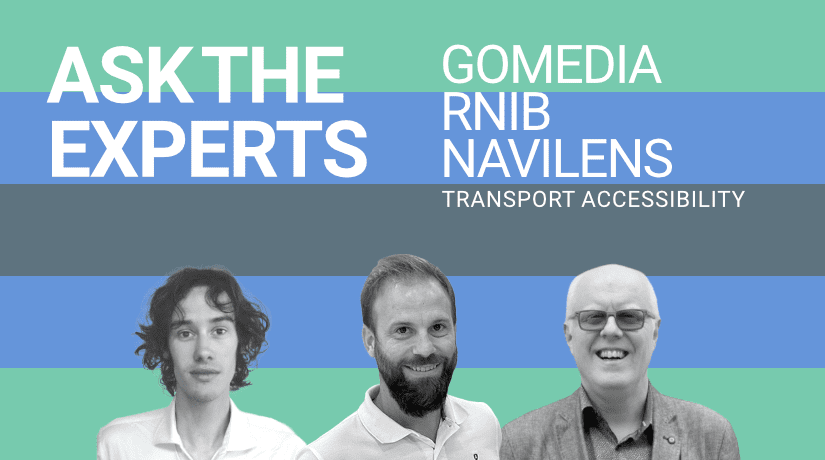Modern, inclusive, and fully accessible transport systems should be stress-free to navigate for all people, regardless of age, medical factors, disabilities, or native language.
The Royal National Institute of Blind People (RNIB) reports that 4 out of 10 blind and partially-sighted passengers cannot make all the journeys they need or want to make. This is particularly important as there are currently many potential passengers being locked out of using the most environmentally friendly mode of transportation.
To find out how digital technology is used to provide accessible public transport, as well as how it compares to other industries, we asked some questions to RNIB’s Head of Inclusive Design, Robin Spinks, as well as experts in the field of digital accessibility solutions for public transport: Sven Koster, Head of New Business Development and Innovation at GoMedia, and Raúl Moreno, Head of Strategic Partnerships and Projects at NaviLens.
Question 1: Can you tell us about NaviLens and how it is combining with GoMedia to improve Accessibility on public transport?
 Raúl Moreno, NaviLens: NaviLens is a groundbreaking technological solution initially developed to help people with vision loss navigate their environment independently. Blind people and those with other degrees of vision loss either have difficulty or are unable to use traditional signage and, therefore, face significant challenges finding their way in unfamiliar environments, particularly busy ones like public transport stations.
Raúl Moreno, NaviLens: NaviLens is a groundbreaking technological solution initially developed to help people with vision loss navigate their environment independently. Blind people and those with other degrees of vision loss either have difficulty or are unable to use traditional signage and, therefore, face significant challenges finding their way in unfamiliar environments, particularly busy ones like public transport stations.
This innovative technology employs a distinctive system of high-contrast, color-coded symbols—readily detectable and interpretable by smartphones or specialised cameras and easy to recognise by people with vision loss. These dynamic NaviLens Accessible codes encode a wealth of information, including location details and directions, empowering users with real-time access to relevant and contextualized data based on where the code is located.
This is where GoMedia plays a pivotal role in applying the solution to public transport. By linking NaviLens to GoMedia’s real-time passenger information database – A blended service called “Visor” – users simply scan the NaviLens Accessible codes with their smart device to get fully up-to-date journey information in real-time.
Users can benefit from the help of the app’s voice assistant to continue their journey, with practical information including descriptions of physical elements, guidance indicators, and real-time arrivals, departures, and delays.
 Sven Koster, GoMedia: GoMedia believes that a better journey experience leads to increased customer satisfaction and more public transport usage overall. To deliver better transport for everyone, it is important to take an inclusive approach with our digital passenger experience, catering to people of all backgrounds and abilities.
Sven Koster, GoMedia: GoMedia believes that a better journey experience leads to increased customer satisfaction and more public transport usage overall. To deliver better transport for everyone, it is important to take an inclusive approach with our digital passenger experience, catering to people of all backgrounds and abilities.
When RNIB introduced us to this wonderful technology around five years ago, that allows blind and partially sighted people to access information in a format that works for them, we were excited by the prospect of helping passengers make their journeys independently by combining NaviLens’ innovative wayfinding technology with GoMedia’s digital journey information service.
Since partnering with NaviLens to help passengers with sight loss, we’ve gone on to identify and develop an ecosystem of accessibility solutions for public transport, that also address the needs of passengers with hearing loss. These including personalised onboard announcements co-developed with the charity Hearing Dogs for Deaf People, as well as personalised digital signers, developed with Signapse AI.
 Robin Spinks, RNIB: What sets Visor apart is its holistic approach to user experience, which is encapsulated in a single, easy-to-use app. Thanks to its versatility, the solution has been applied in a variety of ways, from domestic settings to inclusive tourism experiences, and spanning all modes of transportation.
Robin Spinks, RNIB: What sets Visor apart is its holistic approach to user experience, which is encapsulated in a single, easy-to-use app. Thanks to its versatility, the solution has been applied in a variety of ways, from domestic settings to inclusive tourism experiences, and spanning all modes of transportation.
Users do not need to know precisely where codes are placed and can receive the information they need in a variety of formats and languages, all through an intuitive, user-friendly app.
Question 2: What are some of the specific challenges you have to consider when deploying the solution and how do you overcome them?
Raúl Moreno, NaviLens: We have worked with several multinational companies across a range of industries, including Kellogg’s, Proctor & Gamble, and Coca Cola, all of which use NaviLens technology to relay important product information to consumers using the NaviLens codes, whether they experience vision loss or not. Whether a single NaviLens code is applied to product packaging, or whether hundreds of codes are integrated into large environments like train stations, proper placement is key.
It requires close collaboration between several stakeholders to assess and determine the best possible locations for codes to be placed, for example considering how items will be stacked on shop shelves, or where to display codes to form the most efficient path through busy stations from one mode of transport to the next.
Clear communication and effective project management are therefore vital to any installation and choosing partners that can successfully see deployments through from start to finish is a tremendously beneficial consideration for every party involved.
Sven Koster, GoMedia: With several deployments of Visor completed, we have faced and learned from a variety of challenges across several different public transport environments.
Through our West Midlands pilot, we proved that we could implement the solution for a total end-to-end journey. We could guide passengers with sight loss to successfully find the tram stop, identify the correct tram as they boarded, based on the journey they selected in the app, and then get off at the correct stop as well.
When we deployed Visor at one of the UK’s busiest rail stations, London Euston, we were presented with an extremely busy and highly dynamic environment. Other station improvement works were being conducted while thousands of passengers moved around the space daily. This required very careful planning and cooperation with the UK’s rail infrastructure provider, Network Rail, to ensure that passengers were given the best possible route through the station and avoid disruption.
On our most recent deployment on the Docklands Light Railway (DLR), we encountered new challenges still. For example, the solution deployed at Cutty Sark station had to provide users with fully up-to-date information, despite being completely underground with no cellular connectivity.
Robin Spinks, RNIB: Every location is different. Every physical building is different architecturally, be it a railway station or a light rail station, or a bus station, or a subway. All of those stations and environments have got different characteristics and I think what’s really important for us is that we capture the user experience across different contexts, so we’ve been able to help pilot this solution on product packaging, at a major bus station in the West Midlands, and on four DLR stations with really high footfall.
We are really excited to get all of that information from as many different contexts and users as possible, with different eye conditions and different levels of confidence. All of that helps us build a better picture and ultimately to enable people to move around more confidently.
An obvious thing for us to do is to partner with organisations who are stakeholders in this space and use their infrastructure and expertise to achieve some positive change and make travel easier for people. It’s all about opening up opportunities, improving confidence, and enabling people to get about. We can’t do that on our own, but we can do it by working with great partners like GoMedia.
Question 3: What can the public transport industry learn from other sectors in making their services more accessible?
Raúl Moreno, NaviLens: There has undoubtedly been some financial uncertainty across the globe in recent years and, in an industry where spending is carefully and publicly scrutinised, it is understandable that some hesitancy can arise when thinking about whether to deploy new technologies, particularly across entire transport networks.
This is where we believe that solutions like Visor can truly make a difference, by bridging the gap between tried and tested technologies and new ways of providing customers with the information they need to make informed decisions. The way that information is presented to passengers has a significant influence on their choice of transport and by providing a more efficient, enjoyable navigation experience, passengers will choose to use public transport more often over other, less sustainable modes of transport such as cars.
Sven Koster, GoMedia: If we take major cities as an example, there are a number of factors affecting public transport usage which transport planning authorities may not have fully considered. In addition to passengers with physical accessibility needs, there are several “hidden disabilities” that may affect whether passengers can use traditional signage and announcements, for example passengers with low literacy levels or hearing loss.
It is also important to consider tourism in these environments. Tens of millions of tourists can pass through the world’s busiest cities every year, many of whom may not have high English reading comprehension levels. By providing them with updates in their native language, these users are able to make their journeys more quickly, safely, and independently, reducing strain on passenger information services and station congestion, making the service more attractive and efficient as a whole.
Robin Spinks, RNIB: That’s correct – You don’t need to have vision loss to try Visor. You can download the app as a sighted person and give it a try, because there’s an additional benefit alongside the benefits that blind and partially sighted people experience, for example: Having information in your native language. If you’re a native German speaker, for example, and you’d like to have signs and announcements in your native language, or find a step-free route around the environment, you can do that with Visor.
In terms of the public transport industry, every piece of research that we do around blindness and sight loss indicates that mobility, travel, and getting around continues to be one of the biggest barriers that people face, wherever they are in the world and that’s certainly the case for two million people with sight problems here in the UK.
By keeping such a large number of people locked out of the public transport system through inaccessibility, there are millions of pounds, euros, and dollars in ticket revenues that is not being realised, not to mention the impact on the economy as a whole when people find it difficult to get out to work, enjoy leisure activities, or buy products. For example, transport operators in the West Midlands alone are missing out £4 million of revenue every year because their public transport system isn’t fully accessible.
Question 4: How do you foresee Visor becoming more widely adopted across the public transport industry?
Raúl Moreno, NaviLens: There is often a potential for reluctance to adopt new methods, particularly in more traditional or established environments. The aim is to continue to prove the accuracy and reliability of the system in diverse real-world conditions, such as varying lighting conditions and crowded spaces, through both live deployments and technological trials.
As NaviLens continues to establish itself as the most cost-effective, efficient, and user-friendly accessibility solution to deploy, we hope that more widespread adoption across transport networks should become a reality, as it has in multiple cities and public spaces, and on consumer products worldwide.
Sven Koster, GoMedia: Many of the major players in the public transport industry are now discussing NaviLens technology and, by packaging it into GoMedia’s successfully tested Visor solution, we can combine our resources, expertise, and industry knowledge to deploy the solution quickly and cost-effectively, anywhere in the world.
We are continuing to gather some highly positive feedback from passengers and transport operators alike and the more we can use this to talk about passengers’ accessibility needs and how to solve their challenges, the closer we get to public transport systems that are fairer and more inclusive for everyone.
Robin Spinks, RNIB: We encourage everyone to try Visor for themselves. Download the NaviLens app and let us know what your experience is like. We are always keen to try new approaches and pilot products in new areas.
So, watch this space, we’ll be doing more for sure.

